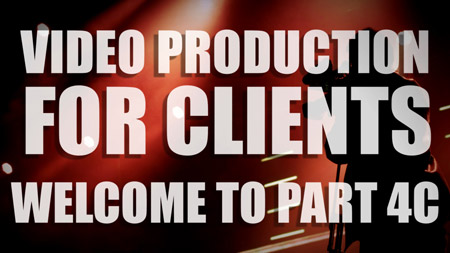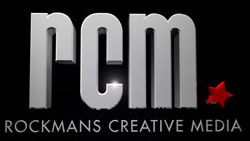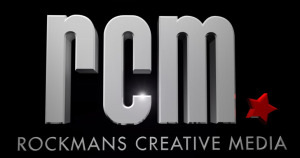4C: Video Production Process Part 3
Video Post Production: Putting All the Pieces Together.
A Guide to Everything You Need to Know to Get the Most From Your Video Marketing

Except with a jigsaw puzzle you take a picture that is already completed and then cut it up so other people can attempt to fit it together.
With the video production process you have to go out and create the pieces before you fit them together!
We prefer to think of it like a carpenter that chooses the wood they want to use from the felled trees and then cuts the wood to create the raw material that will be then used to cut out the various pieces that will make the jigsaw puzzle!
Ok quick recap from our previous two parts of this chapter:
Phase One (Pre-production) : The Production company plans what they are going to do.
Phase Two (Production) : The Production company creates the main elements that will be used in the final video/s
Phase Three (Post Production) : The Production company then takes those elements and puts them together to make the make the final videos.
This Page is all about Video Post Production! The process of putting all the pieces together.
In this section you will discover how all the different elements come together, the Key Crew that are involved in Post Production, and the key elements to get right during this phase to ensure a successful video production process.
A Quick Note:
To keep things simple for this part of the guide, we are going to pretend that all Post Production happens after everything has been shot and there is no more shooting to be done.
In actual fact it’s quite common in modern production processes to have an editor on set starting the post production, as well as leaving room for further shooting after an initial round of video editing.
Also like the production phase, every post production process can be unique and different production companies will have different variations of the process.
The below example used is a generic summary of what might happen in your next video production.
Part 01: Table of Contents:
Each part of the guide has it’s own table of contents so you can get the info you want quickly and easily!
What Happens During Video Post-Production?
In an nutshell – All the raw ingredients of the production are organised and then systematically put together and refined until it results in the finished video/s.
This can involve Broadcast Designers, 3D and 2D Animators, Voice Over Artists, Music Composers, Audio engineers and Video Editors and Close Caption (subtitle) Editors
Although there can be multiple processes at work during pre-production in the end they all end up in the edit suite – this is the central point where all the elements are combined and mixed together.
The Edit Suite.
Almost a misnomer these days – thanks to modern technology and edit suite can consist of nothing more than a decently specked out laptop or desktop. In fact in the last 20 years the advances in technology have completely transformed the entire production process – with video post production seeing some of the biggest changes.
That being said – most Professional Video Editors will tell you no matter what they use to power their editing software, they prefer having a specialised separate work area with plenty of top quality screen space and crystal clear speakers to do their job on.
As one of our editors once said – sometimes portable is not ideal. (- we digress.)
The Key factor about modern video editing software is a process called Non-Linear Editing or Non-Destructive editing.
In fact without getting into a big history lesson, the big jump from the old technology “Liner Editing” to “Non Linear Editing” was very similar in many of the same ways as that of the trusty typewriter and the modern word processor.
Like a word processor, in today’s Video Editing systems, the operator can cut and paste, insert, move, delete, undo, duplicate, format from templates and save multiple copies easily and very effectively.
So What Does An Editing System Do?
Well let’s stick with the above analogy.
Video Editing Software is a word processor for Pictures and Sound.
Instead of having a Document that you read from top left to right until you get to the bottom.
You have a timeline that starts at 00secs and goes until you want it to end.
Each Version of a time line is called a sequence.
The Video Editor places elements onto the timeline (sequence) and arranges them to create the video.
In just the same way you can place words over images and create layers in Microsoft word – the Video Editor can create layers of all sorts of elements like video, text, graphics, voice over, music, sound effects, colour tones and textures.
Just like a Print or Literary Editor, often the process involves having a big “rough copy” and taking things out and moving things around until the result is succinct and at its most worthwhile or practical for its purpose.
There’s no use having a 15 minute commercial for your latest product if you know that your audience is likely to stop watching after 90secs!
But unlike a Print Journalist or a Writer, the Video Editor is limited to a very specific amount of elements that are provided to them. For this reason it’s always preferable to shoot more than you need for the final edit during production so that the video editor has more scope and flexibility in how the project can go together.
That being said too much to choose from can also be a problem.
Imagine that you had to learn and become familiar with all the words you know in the English language before you wrote an email!
Well that’s kind of what the video editor who has too much to choose from has to do per project that they work on.
They have to get to know all the elements available to them before they know which ones are the best to use!
This is where good organisation and time management comes in.
If the Video Editor can refer to a script and a specialised list of the all the shots recorded, called a log sheet and maybe a storyboard, they can see what shots should go where on the time line – and what takes of the shots are the best to choose from.
This way they only have to become familiar with the best of what was shot instead of everything!
It’s the Producer’s (and sometimes the Director’s) job to help guide the Editor to the best shots quickly and easily.
The Video Editor will create an initial cut or rough copy of the sequence.
This will normally consist of all the elements that were shot as they are supposed to appear according to the script, perhaps some rough graphics and perhaps even the music that is likely to be used (if any).
There will be little finessing involved – so although the sequence of the shots will be edited with skill, there will likely be some room for improvement, the audio levels will be mixed roughly with the music made lower and the voices raised a little higher – but nothing to a professional standard.
Hot Tip!
At this stage it’s not uncommon for Clients such as yourself to be asked to review the sequence and give your feedback – if this is the case and you are reviewing a first draft, its best to try and keep in mind that the rough edges so to speak are often intentional.
That being said – if you have any doubt about something that looks a little weird or strange to you – voice your concern – you’d hate to find it in the finished product that was intentional all along!!
You may want to preface it with a statement like:
“I’m not sure if that’s just part of the rough cut but is there supposed to be….”.
Audio & Graphic Design
These days Video Editing software and other software it comes packaged with give users the power to create broadcast graphics, animations and even record voice overs and mix the audio to a professional quality.
Depending on the complexity and also the price of your video, your Post Production may be kept entirely within the computer that runs the edit suite.
For the sake of this example we’ll assume that the video project is using a separate Broadcast Designer for the creation of the Graphics and a sound studio to record a voice over and do a final professional mix of the audio.
Once the Producer or Video Editor knows the durations that are needed for the graphic elements the Broadcast Designer will be informed and maybe given a rough cut of the sequence to base the graphics on and to get the timing right. (if needed).
Then the Designer will send the graphics to the edit suite and the Video Editor will add these as top layers of the sequence.
In some productions a voice over will be performed by a professional Voice Over Artist or Actor and used to build the production around it.
But in most productions that require a voice over – a temporary amateur voice over will be recorded by one of the staff at the edit suite and used as a guide track.
When the Video Editor has created a sequence that gets the approval of the client and all the timings of the shots and audio grabs and any music elements are locked in, this will be labelled something like final draft sequence or unmixed master and will be sent to the Audio Studio.
There a Professional Voice Over Artist/Actor will be recorded, laying down the voice over.
The Audio Engineer will then make sure all the audio elements are given the professional treatment, sound effects may be added and the whole lot mixed together.
Hot Tips!
If you know that your production is going to be played on various different environments tell your producer – as they can get the Audio engineer to mix each version to be best suited and sound the best for each of those environments!
The Audio engineer will output the final mix for each video and send it to the Video Editor who will add the mixed audio to a copy of the Final Version of the sequence – this will have all the graphics in place and all shots treated to suit the look that your production requires.
Then depending on where it’s going to be viewed, the Video Editor will get it ready, output it to the correct formats and send it where-ever it needs to go!
Letting the Producer know what you plan to do with the finished video/s is crucial as there may need to be pre-formatted to suit.
For example : Television Commercials need to have the audio mixed at very specific levels with certain colour saturation restrictions, often with slates or ID boards created and running for 5-10 seconds before the video starts with a 2 seconds of black in between.
Depending on how you are going to use them on the net may also change how the Video Editor will prepare them for you.
Key Crew During Post Production:
There from the start to the finish – If your video production was a house being built the Producer would be the architect. They oversee each element of the Post Production process.
The Producer:
The Producer, understands better than anybody how all the pieces of the production fit together. (Sometimes this role is picked up by the Director).
The Producer will brief and review the work of each of the Post Production principal staff – the Video Editor, Broadcast Designer, Animator, Voice Over Artist and the Audio Engineer.
The Producer will make sure that all of the elements are delivered to the Video Editor on schedule.
It’s also the Producers job to present the various versions of the sequence to you, the client as agreed upon in the production schedule at the start of the production.
The Video Editor:
The main star of the Post Production phase is the Video Editor.
If the Producer is the architect of your video production then the Video Editor is the Head Engineer or the Master Builder.
The Producer has a plan on how the house is going to look but the Video Editor is in charge of the main construction.
Good Video Editors are worth their weight in gold – as they can often manipulate pictures and elements in way that really make a production shine.
Ever heard the saying “we’ll fix it in post”?
They can also save a production if the worst has happened and a crucial part of the video shoot comes back damaged or missing or simply does not work as envisioned.
They can see possibilities to make the production better than originally intended and can even do some last minute magic if you, the client throw a spanner in the works with a change at the last minute!
The Audio Engineer:
Nothing will ruin a video production faster than bad audio, the Audio Engineer is the unsung hero of the Post Production team.
In most cases if the Audio Engineer is doing their job then you won’t even notice – that is until you compare it to how it sounded before they worked their magic.
A quick tip: Just don’t get them talking about psycho-acoustics it may do your head in!
The Broadcast Designer:
Part Graphic Designer, part Animator – this artist creates work that flows over time!
A Broadcast Designer can create Graphic elements for your videos to give them personality, convey an individual authentic feel, re-enforce your brand or unify the entire video.
A clever and inexpensive thing you can do to lift your branding on your next video is to create Video Into’s and Outro’s that turn your Logo into a 3d animation!
Check out our Video blog on this here.
Video Production Process Conclusion: That’s a Wrap !
As you can see a lot goes into a professional production – the video post production process is just one of the important phases. The more complicated the production, the more moving parts there are.
Like anything complex, the more moving parts you have the more things can go wrong.
But there are things that can be done and put in place to reduce the risk of things going wrong.
Good Communication – it’s key to make sure that everyone is pulling in the right direction – and that direction is exactly where you, as the client want your production to go.
Organisation – using a Video Production company that is organised means that they will have tried and true systems that allow them to get more done in a more efficient manner with fewer mistakes.
Experience – Having experienced professionals, who have done this many times, are familiar with the equipment and what needs to be done – means that unneeded experimentation is taken out of the equation which reduces mistakes, wasted time and budget and results in a much more professional polished product.
As the client it’s your right and responsibility to ask any questions that you seem might be needed so that you can understand what’s going on or even just get reassured that what’s happening is in the best interests for your company.
Don’t be afraid to ask stupid questions and you’ll avoid stupid mistake being made.
And never assume – no matter how good the Video Production crew are that they hold all the answers or are aware of something that looks like an glaring mistake to you.
Just bear in mind that there is a difference between being kept in the loop and taking control or micro managing.
Very rarely do the latter two result in a good production process.
Don’t Miss Part 5!
In the next chapter we’re going to delve a little deeper into this.
We’re going to look at what you should expect from your Video Production company, how to pick a Video Production company that will be the best fit for you and your brand and how you can create a working relationship that is guaranteed to give your videos the greatest chance at being the best that can.
Click here to go to Part 5 What to demand from your video Production Company.
Video Production for Clients Guide Table of Contents:
Here’s An Index of Every Chapter:
So you can get the content that interests you the most!
02 Choosing the Right Video Production Type
for Your Business
4A: The Video Production Process,
How Professional Video’s are Created
4B Phase 2: Production – Lights Camera Action
06: How Long Does a Video Production Take?
7B: How to Leverage Your Completed Videos.
Self Hosted Vs YouTube
08: Common Mistakes and Pitfalls
Unsuspecting Companies Make
Getting A Video Production Created.
09: How to Make Sure That Your Next Video Production
is Created Stress & Risk Free… …and an Elephant
Ready To Get Started?
Why Rockmans Creative Media?
Rockmans Creative Media brings a professional skill set and over 18 years ongoing television experience to your video project.
We understand that we are custodians of your brand.
Our videos are unique, and are tailor-made to meet your company objectives.
We know how to produce engaging, attention grabbing and interesting videos.
Email Us At Sales@rockmanscreativemedia.com.au or fill out the contact form.



